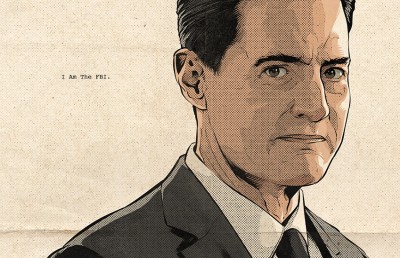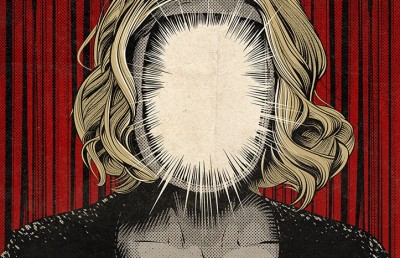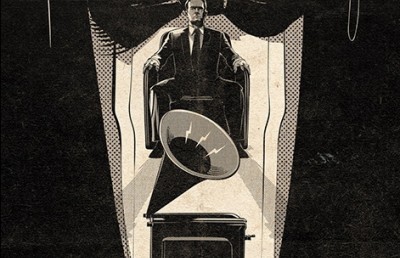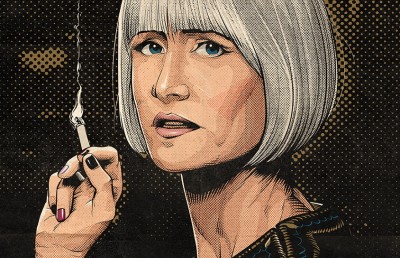Circling the Void: Twin Peaks Returns
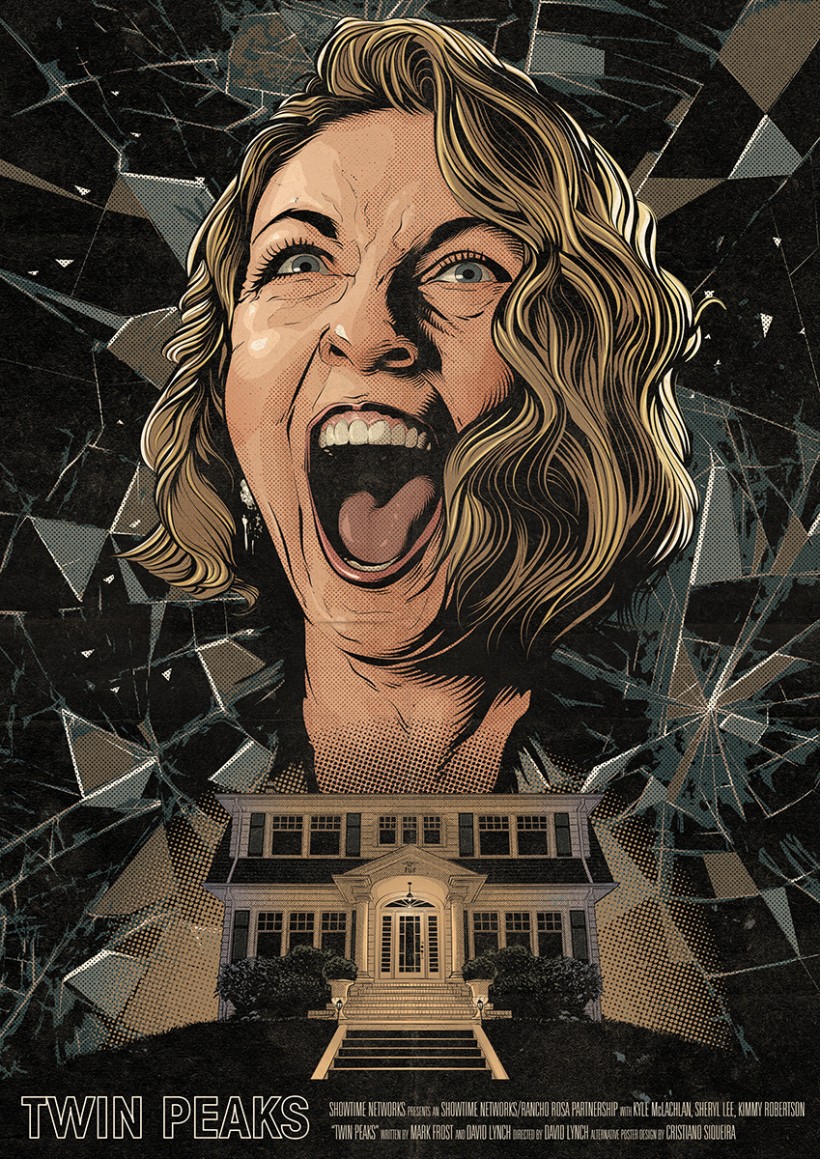
Image courtesy of Cristiano Siqueira
I’ve been circling back to Twin Peaks: The Return since I watched the finale, like I’m tending to a wound. That final sequence of events created an opening in me through which I caught a harrowing glimpse of the abyss.
A stricken Dale Cooper (Kyle MacLachlan) asking, “What year is it?” Then, the weighty silence that follows upended by the barely-audible voice of Sarah Palmer (Grace Zabriskie) wailing her daughter’s name from some other time or some other adjacent universe, deep within that wretched house. In a moment of recognition, as though roused by her mother’s unearthly grief, Carrie Page (Sheryl Lee) remembers a half-forgotten primal anguish, the unbearable agony of being Laura Palmer, and releases a hair-raising, blood-curdling, and stomach-churning scream.
The vocal equivalent of an atomic bomb, the scream discharges a pulse of energy so powerful that it causes the vast electronic dream-world of Twin Peaks to short-circuit. The house, once humming with the sickening whirl of ceiling-fans and lit by the sallow glow of tungsten lamps, is finally quiet, still, and dark. In that protracted interval of darkness, it feels as though the whole universe of Twin Peaks has been pulled into a black hole. We are left with an ethereal image of the show’s event horizon: a slow fade-in reveals Laura, back in the Red Room once again, whispering terrible secrets into Cooper’s ear.
My initial reaction to what unfolded was one of overwhelming, suffocating, existential horror. It was as though the story of Twin Peaks had suddenly been revealed to be a torturous, futile exercise in the eternal return of the same. Our beloved characters were trapped inside some subterranean level of hell, one from which, unlike the exception described in Dante’s Inferno, there is no escape. Instead, one layer is nested into another like a sinister set of Russian dolls. Try as he might to deliver Laura from the clutches of evil, Cooper will always fail. The past dictates the future. All roads lead back home, The Return ostensibly suggests: to the beginning, and thus, to the ground zero of Laura’s suffering. She is doomed to be a homecoming queen forever.
Perhaps this is the ending we deserve, I wagered. After all, we would do well to remember that Laura’s torture, trauma, and violent murder at the hands of the men who made her—Leland Palmer, Mark Frost, and David Lynch— were the very catalysts for the series in the first place. Her pain and sorrow fueled Twin Peaks as much as it fed the malevolent spirits of the Black Lodge. Any genuine return to the series had to arrive armed with this one cruel caveat.
And yet, Laura’s suffering was never meaningless, it had always been more sacrificial than sadistic. Fire Walk with Me, for example, gave her pain both significance and scale. The film, which takes place before her death, fleshes out her character, allowing her to be a living, breathing, compelling human being, moored meaningfully to the many worlds in which she traveled. The original series—now in retrospect— was never just about her devastating absence. It was about her persistent presence in the negative space she left behind. She may have been violently struck from the world, but something of her remained to testify to the sheer force that her being exerted on the Twin Peaks universe. As the origin of and impetus for the series, then, it makes sense that The Return would entrust her with the last word.
Of course, it’s not a word she expresses, but a scream, followed by a whisper. The former is a painfully perceptible vocalization, a communicative excess, while the latter, a frustratingly inaudible disclosure of nothing. Both, however, affirm the stubborn fact that whether beyond our understanding or just out of earshot, the truth of existence—Laura’s, the show’s, our own—is ultimately unknowable.
This unsettling encounter with incomprehensibility makes only one thing clear: that language is woefully ill-equipped to describe, what Albert Rosenfield (Miguel Ferrer) calls, “the absurd mystery of the strange forces of existence.” I am uncomfortably aware of the insufficiency of language as I write this piece, and especially so any time I am tasked with speaking to anyone about what transpired in The Return. And yet, I cannot resist the urge to offer up words to the experience anyway. The series doesn’t so much defy interpretation and explanation as it mires us in them. Follow all the dangling plot threads, track the recurring motifs, and chase after all the devils in the details, and we will only be drawn deeper and deeper into the text. Eventually, we will look up and find ourselves hemmed in at the centre of an immense labyrinth, with nowhere to go.
The Doughnut and The Hole
David Lynch warned us about this kind of theorizing, and the dangers of getting pulled into that deep, dark void. “Keep your eye on the doughnut and not on the hole,” he advised, in a promotional video for The Return, prior to the premiere. It’s an aphorism which Lynch often recites. Repeating it like a mantra, he summons it to stay focused during the creative process. For him, the hole at the centre of the doughnut comes to symbolize an extreme negative force that threatens to swallow up the work. Creative forces are always vulnerable to destructive ones; every act of creation takes place in the shadow of nothingness and meaninglessness. The trick is not to tarry too long on the threshold. Keep it just on the edge of vision and trudge on, steadfast and stoic. We have to learn to live with the hole in the work, and the hole in the world, and most importantly, resist its powerful, calamitous pull. Until, of course, we can’t.
No totalizing theory will ever satisfactorily sum up everything that The Return is. Any explanation is bound to be beset by contradictions, and can only be provisional and speculative. However, if anything at all can be said with confidence about Twin Peaks—in its various incarnations—it is that it is a rich cultural text, one that is as polysemous as it is promiscuous. It can be interpreted in so many ways. That’s not to condemn the series to some crude perspectivism, but rather to commend it for its sociability and its openness. Despite its inward pull, its meaning is not solely lodged inside the show’s many layers of esoteric mythology. There is an outward force to the show as well, and meaning is generated from the connections and resonances it makes in its encounters with viewers. All of this to say, there is a breach in the world of Twin Peaks, an escape hatch, and The Return puts a glass box around it for emphatic effect.
Pandora’s Box
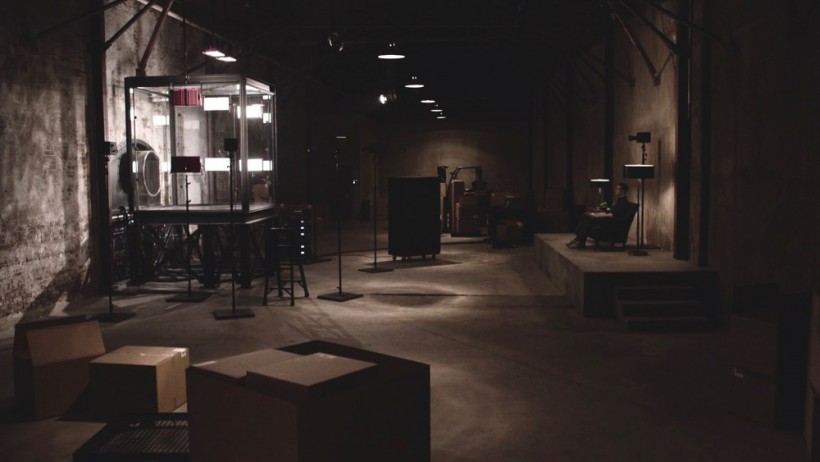
“Woah,” says Tracey (Madeleine Zima), “What is that thing?” “A glass box,” Sam (Benjamin Rosenfield) tells her. He never does explain what it is, and after a brief mention in Part 3, it is never brought up again. The only thing we know about this televisual talisman is that Sam must keep watch to see if something appears inside it. It safeguards a mysterious circular aperture that is embedded in the exterior wall, through which we can see a mystical New York cityscape.
The box occupies the far end of a windowless, concrete chamber, the layout of which is reminiscent of a living room. There’s a couch, a couple of lamps, an end table, and even a potted plant. The room itself is located on the top floor of a skyscraper, in what could very well be a clandestine wing of the Showtime Network’s headquarters. Propped up on a stage, the glass box is monitored not only by Sam, but also by a series of cameras. Stationed at different heights and angles, their arrangement is strangely suggestive of a multi-camera set-up for what promises to be the world’s most solemn sitcom. Meanwhile, a security guard sits just outside the room monitoring it all over CCTV. It is a televisual mise-en-scène-turned mise-en-abyme: production, distribution, and reception in infinite regress.
Aesthetically, the glass box evokes those ghostly cages that Francis Bacon often painted around his figures. Lynch is a fan of Bacon’s work to be sure, but this is no ostentatious referencing. Bacon used vitrines such as these as compositional interruptions. They partitioned the visual field in order to lure and secure the observer’s gaze to whatever was contained therein. The placement of the glass box here functions similarly. As Sam and Tracey gather around it, a frightening form materializes inside, shatters the glass, and smites them. The bodies of the lacerated lovers are later found in pre-coital torsion, their broken skulls hollowed like discarded walnut shells. This grisly tableau is served up as a lesson, one in which Sam and Tracey learn too late. The abyss has an irresistible allure to it, but linger too long near it and you will most certainly be devoured.
Terrible Knowledge
“What is this?” Sheriff Truman (Robert Forster) asks Hawk (Michael Horse), pointing to the enigmatic black circle drawn on the elk skin map, the one that hovers over the town’s twin mountains. “Frank,” Hawk replies gravely, “you don’t ever want to know about that.” “Really?” Truman responds. “Really,” Hawk affirms. In the world of Twin Peaks, knowledge of good and evil comes at a great cost. The show is mythic in this way, recalling the originary epistemological seduction of Adam and Eve by the serpent. Sure, the forbidden fruit of the tree of knowledge presents an irresistible provocation. But to partake of it only brings a painful awareness of our own insufficiency, and exiles us from the blissful ignorance of paradise. Some knowledge is so radical that it changes us, our relationship to the world, and our ability to live in it.
The existence of terrible yet tantalizing knowledge has always hung over the world of Twin Peaks. It started with the awful answer to the question, “Who killed Laura Palmer?” However, as the series progressed, that question became less of a narrative draw for both Dale Cooper and the viewers, and more of an existential trap. The unveiling of the killer early in the second season did nothing to localize, contain, or subdue the darkness. Actually, it failed to restore any sense of moral order at all. And, the eventual discovery of the Black and White Lodges only affirmed that the boundaries separating good from evil are as mutable as they are tenuous. Evil is inherently, irrevocably stitched into the fabric of reality. We cannot return the dreadful contents to Pandora’s mythological box, even if by some strange magic we could: that box was always compromised. Pandora didn’t unleash the ills of the world, they were surreptitiously seeping out all along.
The characters on the show participate—to varying degrees—in willful or unwitting ignorance of this manifold reality. There is a reason why Hawk attempts to dissuade Truman from wanting to know more. For to openly admit to its existence would dismantle the foundations of everyday life, and collapse the fragile scaffolding of the human mind. We need not look any further than Cooper’s doppelganger, Dougie, to see the risks of traveling between worlds. A lumbering lacuna where Cooper used to be, he sleepwalks through the world, watching it unfold before him like a series of images on a screen. Meanwhile, anyone who speaks to him is invariably talking into emptiness, destined to have their words returned to them in an endless echolalia.
This formidable knowledge is undeniably dangerous, and it is therefore disavowed. Its presence is still registered on the surface of the show’s reality, however, and deeply felt. Dark secrets have a potent energy signature to them, Twin Peaks suggests, an energy that flows out, infuses, and consequently distorts the very shape and substance of the diegetic space. Terrible knowledge draws attention to itself: it leaves clues, it wants to be found. It slows the cadence of speech, emboldens the color of lipstick, drops fish into percolators, and amps up interest in silent drape-runners.
Indeed, Twin Peaks is a quirky little town populated by odd, off-kilter characters prone to excesses of feeling. Its plots are mercurial and sometimes mad, riddled with coincidences, obsessions, repetitions, and strange tangents. These eccentricities, however, are not authorial affectations, or aspirations to be weird for weird’s sake. Rather, they are effects produced by the gravitational pull of this deep, dark knowledge floating at the edges of the frame. The whole world is weird on top, because it is fundamentally wild at heart.
Awakenings
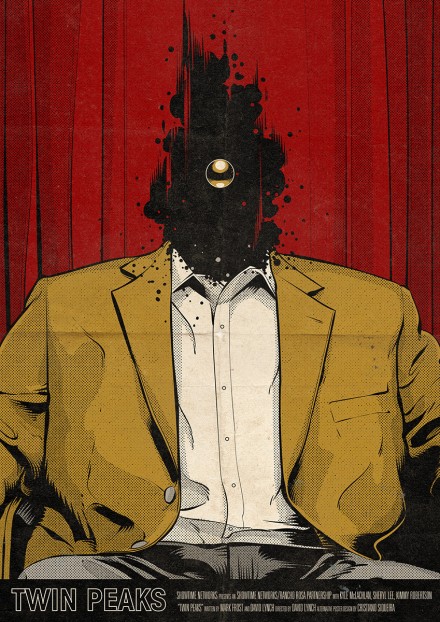
Twin Peaks has a hole in it. This opening is a vortex, a passageway between worlds. It is where the town connects with the Black and White Lodges, and where it becomes susceptible to the forces of good and evil. But it is also where the fictional space of Twin Peaks the series connects with reality, where it encounters the real world—our world—and the destructive, creative, and transformative forces of space and time. The characters have always felt that something is not quite right in Twin Peaks, but The Return amplifies this eerie feeling. As the series careens towards its end, many of the characters don’t seem or feel like themselves. The characters are awakening to the conditions of their creation, and becoming aware of their own finitude.
Put another way, they are realizing they are characters in a television show, that they are tulpas, to use the term made available in The Return. That is, they are thought-forms, thoughts made manifest in human form, who have been created and called back to Twin Peaks for a purpose, a purpose that is now beginning to wane. To identify them as such does not diminish them. Rather, in the world of Twin Peaks what is real and what is not real both exist fully and equally. In this regard, Mark Frost and David Lynch grant their creations a kind of grace rarely allotted to fictional characters, bringing a genuine gravitas to what it means to create and be created.
Cooper and Laura confront the reality of their existence without fanfare at the end of Part 18. After their silent, dreamy night drive back to Twin Peaks, they ascend the stairs to the Palmer house and knock expectantly at the door. Rather than a familiar welcome, they are greeted by the blank, expressionless visage of a stranger named Alice Tremond, played tellingly by the property’s real owner, Mary Reber. This interjection of the real at the very end of the story confirms what the show has been hinting at all season: that there is indeed another world beyond the limits of Twin Peaks. Ben (Richard Beymer) and Beverly (Ashley Judd) listen to its otherworldly call ringing from the basement at the Great Northern Hotel. James Hurley (James Marshall) hears that same sound as he surveys its grounds. Cooper eventually answers the call of this other world, and disappears into it. He comes out on the other side as a man named Richard.
Audrey (Sherilyn Fenn) too, is awakening to the conditions of her creation. “I’m not sure who I am, but I’m not me,” she yells in exasperation at Charlie (Clark Middleton) in Part 15. After the reverie of her dance is violently interrupted at The Roadhouse at the end of Part 16, she frantically pleads with him, “Get me out of here!” And just like that, she is wrenched out of the diegesis. She re-appears dressed in white and bathed in bright, high-key lighting. She stares in bewilderment into a vanity mirror like one might find in a dressing room. “What? What?” she repeats over and over, reeling with confusion, a horrified expression on her naked face. It is as though she has been dropped into some kind of mystical green room, where television tulpas wait to be called for their next scene. Unfortunately for Audrey, the plot of The Return no longer requires her, and she is never seen again.
Likewise, “I’m not me,” Diane’s doppelganger echoes, before her form is rescinded, and she is called back to the Red Room in Part 16 (in much the same manner as Laura is back in Part 1). She may not realize that she is actually Laura Dern, but she does know that she isn’t the Diane that everyone else assumes her to be. All tulpas seem to know something of their origins. Even Lois Duffy, the very first tulpa discovered by Albert and Gordon Cole (David Lynch) in 1975, knew full well the nature of her existence when she described herself as “like the blue rose.”
Tulpas have some sense of who and what they are, and also who they were. A tulpa is not so much a tabula rasa, as a palimpsest. The characters seem to feel the experiences of all their manifestations. The sex scene shared by Diane and Cooper, in the latter half of Part 18, catalyzes an emotionally-fraught process of disconnection. It marks a gradual, rhythmic disintegration of their previous selves as they become Linda and Richard, and thus strangers to one another. And yet, it is implied in Dern’s gutting performance during that discomfiting scene that even as Linda she continues to feel the damage of Diane’s rape by Mr. C, even though he is now Cooper turning into Richard. Afterwards, she leaves the motel room as Linda. Richard, meanwhile, continues to identify himself as Agent Dale Cooper who still has a girl named Laura Palmer on his mind.
The tulpas of Twin Peaks are characters, imagined by Frost and Lynch, and played by actors who are also sometimes their acquaintances, friends, or family members. The actors in turn, bring their characters into life and live in them and with them, as do we. There is a sense that their performances blur the boundaries between fiction and non-fiction. Actors are not to be confused with the characters they play, but to say they are not implicated in one another is not right either. The real has a meaningful relationship to—and therefore cannot be separated from—its forms of representation. Frost and Lynch are not simply creators, they are alchemists. They maneuver and merge reality and representation together in ways that suggest they mutable but mutually entangled.
Every performance that is enacted leaves something behind, The Return implies, and there is life in these traces, a capacity to connect, and therefore to endure. Like Hawk’s living map, what is inscribed may be overwritten but it cannot be erased; the marks of existence simply shift to accommodate the present, and give it depth and meaning. No matter the forces of destruction to which they are subjected, there is always potential for existence to persist in some mutagenic form.
Death Is Not an End
“I call the show a cultural compost heap,” Mark Frost confessed in interview with People magazine back in 1990. “There are symbols and characters and expressions from all the shows we saw growing up that echo and ping down the hallways of Twin Peaks.” This is not to define the show as some kind of postmodern pastiche, or as a means of showing off the creators’ extensive popular cultural knowledge. Rather, it speaks to the way cultural forms exist as parts of a collectively shared lexicon, where they engage in meaningful and productive conversation with each other. A song, a gesture, a piece of clothing, a name, or even an actor: all of these entities conjure something personal and shared, and bring something constant and contingent to cultural experience. These relics become touchstones. They can be cobbled together to create an ad-hoc communicative shorthand, to generate moods, tones, and feelings, and a fleeting sense of communion.
And now after all this time, Twin Peaks itself sits atop this cultural compost heap. It will decay but parts of it will endure, as they make fertile ground for new forms. To survive, the contents of the world of Twin Peaks must venture out of the arcane universe of the show and into the real world, explore it, and become something else. Death, as Margaret Lanterman (Catherine Coulson) offers in her poignant final words to Hawk, is just a change, not an end.
An image of a detonating atomic bomb hangs on the wall behind Cole’s desk. Its billowing mushroom cloud is reminiscent of the image of the Trinity Test we see in Part 8. On the opposite wall is a portrait of Franz Kafka, who penned “The Metamorphosis,” one of Lynch’s favourite works. A story of modern alienation, it also features an account of the pain and pathos of Gregor Samsa’s transformation, not just from a human being to an insect, but to a character who has by now become a lasting part of the collective reservoir of popular culture. These are curious images to adorn an FBI lawman’s office, but Gordon Cole is no ordinary lawman, he’s also David Lynch. Together these images represent the thematic logics that are at work in the very nucleus of the series: memento mori and metamorphosis, destruction and transformation.
Twin Peaks has always been about death. In particular, the death—and life—of the character of Laura Palmer. But the specter of real death, immanent, actual, and inevitable, casts a pall over The Return. It’s impossible to watch the show without thinking about senescence and mortality. The original actors have all visibly aged in the intervening years, foregrounding the frailty of human bodies and the implacable march of time. Don. S. Davis, Frank Silva, and Jack Nance died well-before the filming. Some actors died during or after. The Return not only gives us one last glimmer of David Bowie, it also offers indelible parting performances from Catherine Coulson, Miguel Ferrer, and Warren Frost, and now sadly, Harry Dean Stanton and Brent Briscoe. The indisputable fact of real human death renders their performances, and those of the rest of the cast, all the more profound and affecting.
In this way, The Return explores the death, life, and legacy of Twin Peaks the series and everyone and everything it contains. Real death is inescapable, it contends, but symbolic death can be defied. The show emphasizes remainders: what death cannot destroy, what it cannot undo, and what it cannot take into oblivion. “I am dead, yet I live” Laura tells Cooper in the Red Room. She is just one of many characters who persists after her death, continuing to appear and to affect the unfolding narrative, but also to communicate with the living. I know I certainly felt her cross over the moment that scream reached out and touched me from the other side of the screen. Actors and characters, dead or alive are granted the possibility of eternal life in the world of Twin Peaks because they are etched into communicative forms. Despite the changing technological landscape, The Return tries to reassure us, televisual forms are still built for continuity and confluence: they are made to mingle with everyday life.
In the end, The Return leaves us with a beginning, an opening without a closure, a mystery without a solution, and a question without an answer. It is a meditation on what it means to be a character in a television show, confronting the cosmic horror of its own finitude and the obsoleteness of its home universe. What will happen after the apocalyptic curtain call? Indeed, “What will be in the darkness that remains?” Margaret wonders out loud to Hawk, a crucial query for both a dying character and a dying woman. The only way to find out, she alludes, is to “watch and listen to the dream of space and time.” Be vigilant, for representational forms are what carry on, and they have life in them yet. Some aspects of these multivalent forms will, of course, remain trapped in the proverbial Red Room of the text, but others are ready to venture out. Like Adam and Eve spurned from the Garden, Laura and Cooper leave the world of Twin Peaks, the world that was made for them. As changed beings, they odyssey into the great unknown, to forge new connections and new worlds. Exeunt.



